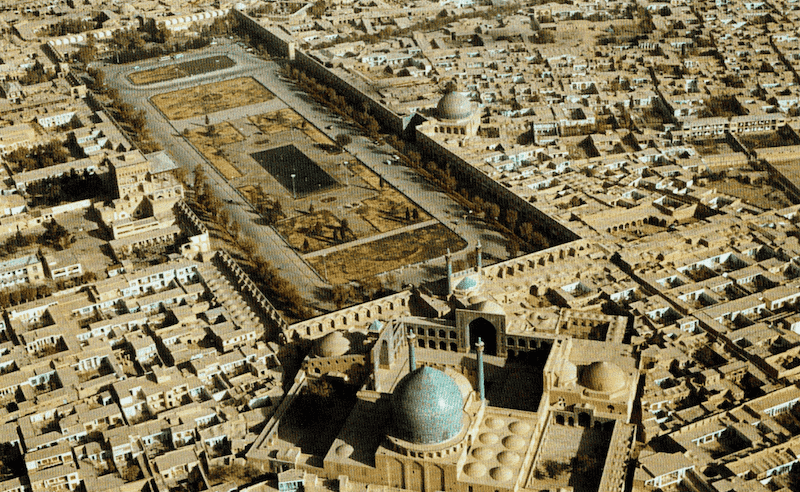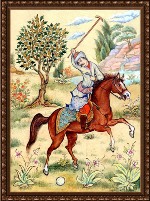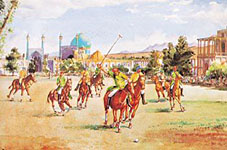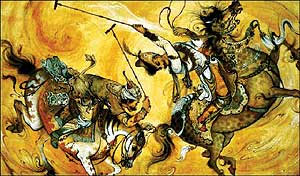Persian Polo (aka Chogan)

Heart of Empire
Reproduced from Hurlingham Polo MagazineThe world's largest and oldest polo field, where the national sport was played by 17th-century Persian nobility, may once more come into its own, says Tanya Jackson
On 11 October last year, 34 mounted polo players slowly paraded through the cobbled streets of Esfahan in Iran on their way to compete on a historic field: the medieval Naqsh-e Jahan, or, 'Image of the World' square. The match was organised by the Iranian Polo Federation (IPF) and the Cultural Heritage, Tourism, and Handicrafts Organization in honour of Iran's bed to have the sport officially registered by UNESCO as part of Iranian heritage. And where else could one hold a match like this, other than the world's largest, and oldest, United Nations-listed polo field?
Second in size only to Tiananmen Square in China, the extensive space was built by Shah 'Abbas I between 1602 and 1630, when he moved the capital of Persia to Esfahan. Measuring 500 x 150m, it was surrounded by a two-storey arcade that is still home to buskers, street vendors and an array of shops. It was the thriving centre of the Great Shah's new empire, where people gathered not only to make purchases and to promenade, but also to attend public celebrations and executions, as well as to watch noblemen and royalty compete in the national sport of polo.
On adapting the existing 15th-century palace for his own use, the shah had the polo field placed in front of his new residence, allowing him a good view of the action from the comfort of his balcony. From the centre of the square, Ali'Qapu palace stands to the west. Opposite, on the east side, is the Mosque of Sheikh Loffallah; to the north, sits the lavish Portia of Qeyssariyeh; and on the south edge of the square is perhaps the most outstanding example of vivid Safavid architrecture: the lapis lazuli and golden-mosaicked Royal Mosque. Ceramic tiles decorate all the buildings on the square, including the arcade, which is painted with flowering trees. Surrounded by such exquisite and detailed artistry, it's difficult to imagine a more distractingly opulent sports ground on which to saddle up and whack a ball about.
The marble goalposts serve as a reminder of how long the game has been played here
To the north and south of the square - though the players of last October's ceremonial match opted not to use them - the original marble goalposts serve as a reminder of how long the game has been played here. 'We hope to stage a similar event as part of next year's MENACA Cup,' says IPF representative Siamack Ilkhani. 'Ultimately, it's our goal to make the square into a proper polo field again.'
Whether or not the UNESCO-listed site is adapted to once again host regular matches remains to be seen. For now, it is at its best during the late afternoons, when the fountains are turned on and families take to the esplanade for their evening walk. In the softer dusk light, the architecture attains its full grandeur, and one gets a taste of just how atmospheric it must have been to play here in the heart of the Persian Empire, in front of the most powerful man in the world.
Origin
"The game of polo is played on horseback with a stick (mallet) and ball. The earliest records of polo are Persian; there is evidence that it was played in the time of King Darius the Great (522- 486 BC)."
Persian polo is described in Sir Anthony Shirley's Travels to Persia (1613)

Polo was invented and first played in Iran (or ancient Persia) thousands of years ago. The original name of polo is "Chogan" and in Iran the game is still referred to as "Chogan". From its Iranian origins in Persia it spread to Constantinople, and eastward through Bactria and Afghanistan to Tibet, China, and Japan, and from Tibet to India, where it flourished throughout the Mughal (Mogul) dynasty. The word "polo" comes from the Tibetan word for the willow root from which polo balls were made of, which is "Pulu".
Polo was the world"s first team sport, the world"s first ball game, and today is recognized as the world"s fastest team sport and ball game. The first recorded game took place in 600 BC, in Ancient Persia. Throughout history, the game has been popular among generals, warriors, princes, and kings as a means of training cavalry for warfare.
Rise in popularity

In the 4th century AD, Shah Shapoor II, the Sassanid king of Persia was known to have learned to play the game at the age of seven. There are also numerous accounts of polo matches played between another Sassanid Iranian shah, Khosrow Parviz and the Armenian princess, Shireen.
During Khosrow"s reign, polo was known to be particularly popular among the ladies of the Persian court. In the 16th century AD, a polo ground (300 yards long and with goal posts 8 yards apart) was built by Shah Abbas the Great, at Esfahan, then the capital of the Safavid Persian Empire. The Iranian monarch would watch polo matches from his terrace at the Ali Ghapu palace.
The polo field, which is called (Meydaneh Naghsheh Jahan) still exists today and it"s dimensions are the standard for polo fields across the globe.
Global expansion

In an interesting letter sent to Alexander of Macedonia from the Iranian king Darius III, Darius sent a polo mallet and a ball to Alexander along with a message telling him that instead of warmongering he should play polo. The Mongol ruler Genghis Khan and the Central Asian warrior Tamarlane (Teymour) were other notable historical personalities, whom were also polo players. Teymour"s polo grounds at Samarghand (in present day Uzbekistan) can still be seen. The Moguls were largely responsible for taking the game from Persia to the east in India and by the 16th century, the Mogul Emperor Babur had established polo in India. In the 1850 the British discovered the game in Manipur (Munipoor) on the Burmese border with India. From there, the English spread the game to Europe and the rest of the Western world.
The ball no question makes of ayes or noes,
But right and left as strikes the player goes,
And he that tossed you down into the field,
He knows about it all. He knows, He knows.
- Omar Khayyam, Rubaiyat of Omar Khayyam
Today some of world"s best players come from Argentina, Australia, Brazil, Chile, India, Mexico, New Zealand, Pakistan, South Africa, the United Kingdom, and the United States. Nonetheless, today the polo supremacy of the Argentine is widely accepted.
Legacy
Evidently, polo has a long and colorful record in Iran. Persian poets have long celebrated the glory of the game in their poetry. Poetic writings speak eloquently of the beauty, excitement, and thrill of the game. The 12th century Persian poet Nizami gave advice on how to live a full life:
The horizon is the edge of your polo field,
The earth is the ball in the curve of your polo stick.
Until you are blotted out of existence as the dust,
gallop and press on your horse for the ground is yours.
- Omar Khayyam, Rubaiyat of Omar Khayyam
Omar Khayyam, the Iranian philosopher, astronomer, mathematician, and poet, used polo as a means of making his philosophical points. Dinvari, the 9th century Persian astronomer and historian, offered general rules for the game, which included the avoidance of strong language and an attempt at patience. Even today, artists painting in the traditional Persian miniature style extensively feature polo in their works. Due to its extensive history in Iran and the fact that the game was first played in Ancient Persia, Iranians recognize polo as part of their cultural heritage. Iranians take great pride in the fact that they created such a beautiful game that is now played across the globe and by all peoples.
■